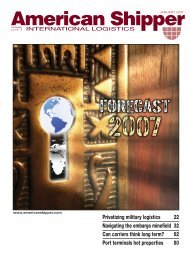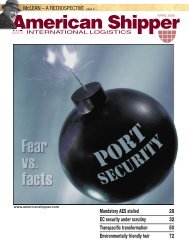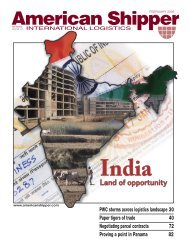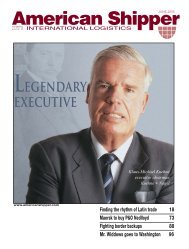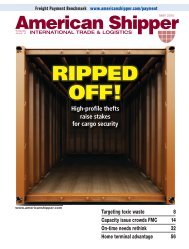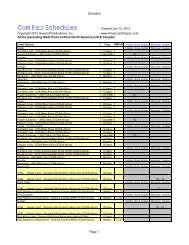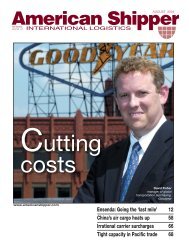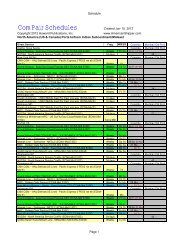Pirate Busters - American Shipper
Pirate Busters - American Shipper
Pirate Busters - American Shipper
Create successful ePaper yourself
Turn your PDF publications into a flip-book with our unique Google optimized e-Paper software.
TRANSPORT / PORTS<br />
Floating an intermodal option<br />
Barge service would provide trucking alternative<br />
to connect Oakland, Stockton.<br />
Ports America sees big potential at the<br />
Port of Oakland for increased moves<br />
of Asian cargo to the U.S. Midwest<br />
by rail. A start-up called Eco-Transport,<br />
believes barge transport may also be a part<br />
of its future.<br />
Alex Yeros is managing director at<br />
Eco-Transport and its parent company<br />
Broe Group, a firm that<br />
hopes to start a short sea<br />
inland barge service that<br />
would move containers<br />
between Oakland and<br />
the Port of Stockton,<br />
located 75 miles east of<br />
the Golden Gate Bridge.<br />
Yeros said the company<br />
was hoping to<br />
launch the service as<br />
soon as September,<br />
believing the time may<br />
be ripe both environmentally<br />
and due to<br />
container shipping industry<br />
trends. He notes<br />
that in recent years some<br />
shipping lines have been reducing their<br />
involvement in inland transportation, and<br />
are encouraging shippers to return containers<br />
quickly so they can be reloaded or<br />
returned to Asia.<br />
Compared to some ports, the flow of<br />
containers in and out of Oakland is more<br />
balanced, and that there is high demand<br />
for export containers to carry agricultural<br />
goods from California.<br />
Last year there were 988,973 TEUs of<br />
import containers that moved through<br />
the Port of Oakland (796,404 full and<br />
192,569 empty), and 1.2 million TEUs<br />
of export containers (910,700 full and<br />
333,860 empty).<br />
He estimates about a quarter of the traffic<br />
is moved through the Union Pacific<br />
and BNSF Railway intermodal facilities<br />
right at the port. Another Broe subsidiary,<br />
Omnitrax, operates the BNSF terminal in<br />
the Port of Oakland, which is called the<br />
Oakland International Gateway.<br />
But because of a lack of space in Oakland,<br />
many of the other containers are trucked<br />
to the Stockton area to large distribution<br />
centers or deconsolidation stations where<br />
44 AMERICAN SHIPPER: OCTOBER 2009<br />
BY CHRIS DUPIN<br />
Source: Eco-Transport.<br />
freight is reloaded into domestic equipment,<br />
he said.<br />
There are about 50 million square feet<br />
of distribution or deconsolidation facilities<br />
in the Stockton area where much is loaded<br />
onto trains at two other rail facilities, the<br />
BNSF’s terminal in Mariposa and UP’s<br />
terminal in Lathrop, he said.<br />
Today, when those containers move in<br />
and out of Oakland, many travel by truck<br />
over Interstate 580 to the greater Stockton<br />
area where they are transloaded into domestic<br />
containers, and the ocean containers are<br />
returned empty to Oakland. Meanwhile,<br />
Yeros said agricultural exporters dispatch<br />
trucks in the opposite direction from the<br />
Central Valley to fetch empty containers<br />
to carry cotton and other agricultural<br />
commodities. This two-way f low of trucks<br />
carrying both full and empty containers<br />
has helped make I-580 the second most<br />
congested freeway in Northen California,<br />
according to the Alameda County Congestion<br />
Management Agency.<br />
Yeros said establishing a satellite container<br />
terminal in the Port of Stockton,<br />
and a second one eventually in the Port of<br />
West Sacramento, could help eliminate the<br />
thousands of container moves each week.<br />
Eco-Transport plans to establish a service<br />
that would use a barge to move up to<br />
350 40-foot containers at a time between<br />
Oakland and Stockton. The company also<br />
plans to coordinate delivery or pickup of<br />
containers from warehouses or agricultural<br />
exports in the Central Valley.<br />
“We are trying to establish a service<br />
within the way the world works today.<br />
This would not involve new ships. It is not<br />
a roll-on/roll-off service. We are going to<br />
load barges the way that ships are loaded<br />
and unloaded and ultimately make the<br />
delivery to customers with trucks the same<br />
way that they operate today,” Yeros said.<br />
In addition to its environmental benefits,<br />
he said the service should appeal to<br />
exporters because they will be able to get<br />
greater access to available equipment “and<br />
we can help them with managing the actual<br />
delivery or pickup of the load. Shipping<br />
lines can improve the cycle time on their<br />
equipment and get a better match in import<br />
and exports of their equipment,” he said.<br />
Yeros said truckers might be able to dray<br />
several more containers<br />
a day to and from the<br />
satellite container yard<br />
than if they have to drive<br />
all the way between<br />
Oakland and the Central<br />
Valley.<br />
William Lewicki,<br />
marketing director for<br />
the Port of Stockton,<br />
said the barge service<br />
could benefit shippers<br />
of heavy commodities<br />
such as pipe or agricultural<br />
goods that cannot<br />
fully load containers<br />
because of weight limitations<br />
on California’s<br />
highways. By barging containers to and<br />
from the port, shippers would be able to<br />
load more cargo in each box. This could<br />
be an advantage to Port of Stockton tenants<br />
such as Ferguson Enterprises, the largest<br />
distributor of pipe, valves and fittings in<br />
the United States.<br />
Lewicki said his port, along with Sacramento<br />
and Eco-Transport, are seeking<br />
federal funding for the short-sea shipping<br />
initiative under President Obama’s<br />
economic stimulus plan. Stockton hopes<br />
to obtain a couple of mobile cranes, one<br />
of which would be devoted to the barge<br />
service. The plan, he said, is to set up the<br />
operation in the port’s western complex,<br />
formerly the Navy’s “Rough and Ready”<br />
supply depot, where containers could be<br />
drayed a quarter mile from berths 19-20<br />
to a container yard.<br />
But even without that crane, he said the<br />
port would be able to accommodate startup<br />
of the barge service in a matter of weeks.<br />
It would, instead, use an existing container<br />
crane to offload the barge — containers<br />
0 - 2,500 trucks per day<br />
2,501 - 7,500 trucks per day<br />
7,501+ trucks per day<br />
Marine Highway Route<br />
Traffic congestion will<br />
be eliminated by moving<br />
containers over the Marine<br />
Highway to Eco-Transport’s<br />
Satellite Container Terminal<br />
in the Central Valley.<br />
would just have to be drayed a mile and a<br />
quarter.<br />
■



